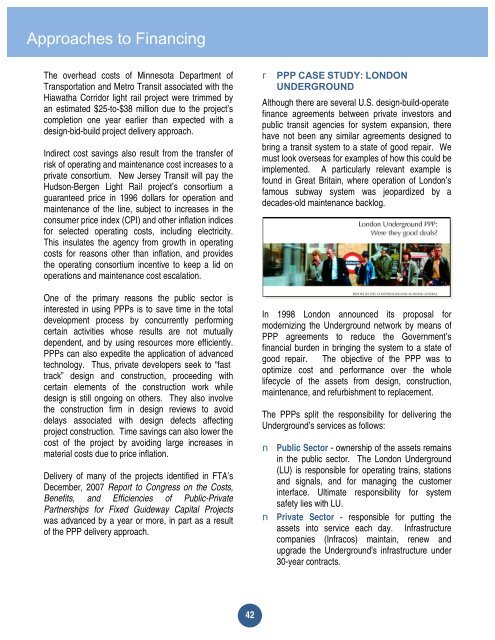Beginning the Dialogue - Report on SGR - Federal Transit ...
Beginning the Dialogue - Report on SGR - Federal Transit ...
Beginning the Dialogue - Report on SGR - Federal Transit ...
You also want an ePaper? Increase the reach of your titles
YUMPU automatically turns print PDFs into web optimized ePapers that Google loves.
Approaches to Financing<br />
The overhead costs of Minnesota Department of<br />
Transportati<strong>on</strong> and Metro <strong>Transit</strong> associated with <str<strong>on</strong>g>the</str<strong>on</strong>g><br />
Hiawatha Corridor light rail project were trimmed by<br />
an estimated $25-to-$38 milli<strong>on</strong> due to <str<strong>on</strong>g>the</str<strong>on</strong>g> project’s<br />
completi<strong>on</strong> <strong>on</strong>e year earlier than expected with a<br />
design-bid-build project delivery approach.<br />
Indirect cost savings also result from <str<strong>on</strong>g>the</str<strong>on</strong>g> transfer of<br />
risk of operating and maintenance cost increases to a<br />
private c<strong>on</strong>sortium. New Jersey <strong>Transit</strong> will pay <str<strong>on</strong>g>the</str<strong>on</strong>g><br />
Huds<strong>on</strong>-Bergen Light Rail project’s c<strong>on</strong>sortium a<br />
guaranteed price in 1996 dollars for operati<strong>on</strong> and<br />
maintenance of <str<strong>on</strong>g>the</str<strong>on</strong>g> line, subject to increases in <str<strong>on</strong>g>the</str<strong>on</strong>g><br />
c<strong>on</strong>sumer price index (CPI) and o<str<strong>on</strong>g>the</str<strong>on</strong>g>r inflati<strong>on</strong> indices<br />
for selected operating costs, including electricity.<br />
This insulates <str<strong>on</strong>g>the</str<strong>on</strong>g> agency from growth in operating<br />
costs for reas<strong>on</strong>s o<str<strong>on</strong>g>the</str<strong>on</strong>g>r than inflati<strong>on</strong>, and provides<br />
<str<strong>on</strong>g>the</str<strong>on</strong>g> operating c<strong>on</strong>sortium incentive to keep a lid <strong>on</strong><br />
operati<strong>on</strong>s and maintenance cost escalati<strong>on</strong>.<br />
One of <str<strong>on</strong>g>the</str<strong>on</strong>g> primary reas<strong>on</strong>s <str<strong>on</strong>g>the</str<strong>on</strong>g> public sector is<br />
interested in using PPPs is to save time in <str<strong>on</strong>g>the</str<strong>on</strong>g> total<br />
development process by c<strong>on</strong>currently performing<br />
certain activities whose results are not mutually<br />
dependent, and by using resources more efficiently.<br />
PPPs can also expedite <str<strong>on</strong>g>the</str<strong>on</strong>g> applicati<strong>on</strong> of advanced<br />
technology. Thus, private developers seek to “fasttrack”<br />
design and c<strong>on</strong>structi<strong>on</strong>, proceeding with<br />
certain elements of <str<strong>on</strong>g>the</str<strong>on</strong>g> c<strong>on</strong>structi<strong>on</strong> work while<br />
design is still <strong>on</strong>going <strong>on</strong> o<str<strong>on</strong>g>the</str<strong>on</strong>g>rs. They also involve<br />
<str<strong>on</strong>g>the</str<strong>on</strong>g> c<strong>on</strong>structi<strong>on</strong> firm in design reviews to avoid<br />
delays associated with design defects affecting<br />
project c<strong>on</strong>structi<strong>on</strong>. Time savings can also lower <str<strong>on</strong>g>the</str<strong>on</strong>g><br />
cost of <str<strong>on</strong>g>the</str<strong>on</strong>g> project by avoiding large increases in<br />
material costs due to price inflati<strong>on</strong>.<br />
Delivery of many of <str<strong>on</strong>g>the</str<strong>on</strong>g> projects identified in FTA’s<br />
December, 2007 <str<strong>on</strong>g>Report</str<strong>on</strong>g> to C<strong>on</strong>gress <strong>on</strong> <str<strong>on</strong>g>the</str<strong>on</strong>g> Costs,<br />
Benefits, and Efficiencies of Public-Private<br />
Partnerships for Fixed Guideway Capital Projects<br />
was advanced by a year or more, in part as a result<br />
of <str<strong>on</strong>g>the</str<strong>on</strong>g> PPP delivery approach.<br />
42<br />
r PPP CASE STUDY: LONDON<br />
UNDERGROUND<br />
Although <str<strong>on</strong>g>the</str<strong>on</strong>g>re are several U.S. design-build-operatefinance<br />
agreements between private investors and<br />
public transit agencies for system expansi<strong>on</strong>, <str<strong>on</strong>g>the</str<strong>on</strong>g>re<br />
have not been any similar agreements designed to<br />
bring a transit system to a state of good repair. We<br />
must look overseas for examples of how this could be<br />
implemented. A particularly relevant example is<br />
found in Great Britain, where operati<strong>on</strong> of L<strong>on</strong>d<strong>on</strong>’s<br />
famous subway system was jeopardized by a<br />
decades-old maintenance backlog.<br />
In 1998 L<strong>on</strong>d<strong>on</strong> announced its proposal for<br />
modernizing <str<strong>on</strong>g>the</str<strong>on</strong>g> Underground network by means of<br />
PPP agreements to reduce <str<strong>on</strong>g>the</str<strong>on</strong>g> Government’s<br />
financial burden in bringing <str<strong>on</strong>g>the</str<strong>on</strong>g> system to a state of<br />
good repair. The objective of <str<strong>on</strong>g>the</str<strong>on</strong>g> PPP was to<br />
optimize cost and performance over <str<strong>on</strong>g>the</str<strong>on</strong>g> whole<br />
lifecycle of <str<strong>on</strong>g>the</str<strong>on</strong>g> assets from design, c<strong>on</strong>structi<strong>on</strong>,<br />
maintenance, and refurbishment to replacement.<br />
The PPPs split <str<strong>on</strong>g>the</str<strong>on</strong>g> resp<strong>on</strong>sibility for delivering <str<strong>on</strong>g>the</str<strong>on</strong>g><br />
Underground’s services as follows:<br />
n Public Sector - ownership of <str<strong>on</strong>g>the</str<strong>on</strong>g> assets remains<br />
in <str<strong>on</strong>g>the</str<strong>on</strong>g> public sector. The L<strong>on</strong>d<strong>on</strong> Underground<br />
(LU) is resp<strong>on</strong>sible for operating trains, stati<strong>on</strong>s<br />
and signals, and for managing <str<strong>on</strong>g>the</str<strong>on</strong>g> customer<br />
interface. Ultimate resp<strong>on</strong>sibility for system<br />
safety lies with LU.<br />
n Private Sector - resp<strong>on</strong>sible for putting <str<strong>on</strong>g>the</str<strong>on</strong>g><br />
assets into service each day. Infrastructure<br />
companies (Infracos) maintain, renew and<br />
upgrade <str<strong>on</strong>g>the</str<strong>on</strong>g> Underground’s infrastructure under<br />
30-year c<strong>on</strong>tracts.

















